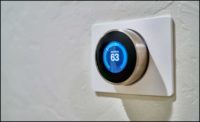As commercial HVAC systems age, they may experience leaks. Because these units are considerably larger than their consumer-grade counterparts, a commercial air conditioning refrigerant leak can quickly become a complex, expensive problem. Resolving these issues as early as possible is essential to minimizing these costs and protecting occupant safety.
Fixing a leak efficiently means being able to spot the warning signs. Here are seven common symptoms of a refrigerant leak to look out for.
1. Frost Buildup — Ice buildup is one of the most obvious signs of a commercial air conditioner refrigerant leak. Gas pressure and temperature have a direct relationship in a contained system. Consequently, when a leak causes the refrigerant to exit the system, the pressure inside drops, leading to a similar decrease in temperature, which can freeze moisture along the HVAC system.
Frost buildup typically occurs on the evaporator coils of an air conditioner, so check these closely. However, freezing can still happen in other parts of the HVAC system, so any ice is a sign there could be a leak. Because few other issues will cause this buildup, icing almost guarantees the refrigerant is leaking.
2. Unusual Sounds — Hissing or bubbling sounds are another telltale sign of a refrigerant leak. Aging HVAC units can make various unusual noises, but some are more problematic than others. A metallic rattling is likely a loose bit of metal — which may not be a pressing issue — but hissing typically comes from air escaping through a small hole, which could indicate a leak.
A bubbling or gurgling noise is an even more concerning sound — these originate from larger holes, where leaking refrigerant bubbles and releases across the opening. Workers hearing these sounds should investigate further, following them to their source to see if they’re coming from a leak.
3. Chemical Odors — Commercial air conditioning refrigerant leaks sometimes will not produce as noticeable symptoms at first. However, as the refrigerant seeps out, it will cause increasingly prominent signs. A strange chemical odor in the air — especially near the a/c unit — is one such signal that workers should be aware of.
While refrigerants are mostly odorless, they do carry a slightly sweet chemical smell in high enough concentrations. Leaks can also release odors from other components within the HVAC system. If these unusual smells appear near HVAC units, shut off the system immediately. Refrigerant fumes are hazardous, so if there is enough in the air to smell, the leak is significant and requires caution.
4. Loss of Cooling Power — If a commercial a/c system starts to lose effectiveness, it could also be a sign of leaking refrigerant. Air conditioning cannot function properly without sufficient refrigerant levels, so it will begin producing warmer air soon after a leak occurs. Consequently, a loss of cooling power should warrant further inspection.
While a leak will impact cooling power, it is important to note failure to produce cold air can stem from other issues too. Air leaks will lower air compressor performance even when everything else in the system is working correctly and these are not as concerning as leaking refrigerant. Still, even if it is not a leak, loss of cooling power indicates a need for repair, so this sign warrants inspection.
5. Long Cooling Cycles — Similarly, unusually long cooling cycles could signify a commercial air conditioning refrigerant leak. Smaller leaks may not lose enough refrigerant for an a/c to become ineffective, but it will take longer to heat the area. Consequently, the leaking HVAC system may not blow warm air, but its performance can still suffer.
Long cooling cycles may eventually become a loss of cooling power as the system loses more refrigerant. However, if workers notice this trend early enough, they can fix the leak before it results in these more dramatic issues.
6. High Indoor Humidity — While managing indoor air temperatures is refrigerants’ primary purpose, it’s not their only one. Air can hold more moisture at higher temperatures, retaining twice as much water vapor at 68°F than at 50°F. Consequently, as refrigerant leaks and a/c systems fail to cool the air as effectively, it can dramatically impact indoor humidity.
If workers in a facility feel more humid than usual and the weather has stayed the same, HVAC professionals should check the a/c system. If left unchecked, high humidity can promote mold and mildew growth, affecting products and threatening air quality levels, so addressing these concerns as early as possible is essential.
7. Higher HVAC Bills — Spikes in heating and cooling bills are another sign the a/c could be leaking refrigerant. As the system loses refrigerant, it will struggle to maintain the same temperatures, causing it to run more often. That will result in higher energy spending, so any spikes in these costs should raise suspicion.
Of course, higher HVAC bills can come from several other factors, too. There could be another issue with the AC system, the overall energy market may be experiencing higher prices, or the facility could be running more electric systems than it usually does. However, businesses must inspect these situations to find the root of the issue, so spiking bills should warrant a leak inspection.
Fixing a Commercial Air Conditioning Refrigerant Leak
If businesses or their contractors notice any of these signs, they should check for a refrigerant leak as quickly as possible. If there is a leak, here are some considerations for the repair process.
Address the Issue Quickly — Above all else, it is imperative to fix the leak soon. Commercial air conditioning refrigerant leaks can be both dangerous and costly. As a/c systems lose more refrigerant, the facility’s HVAC bills will climb and occupants will be at a higher risk of inhaling hazardous fumes.
The EPA requires businesses to repair leaks within 30 days of discovering them. However, it is best to use that figure as an absolute maximum timeframe and try to resolve the issue far before the 30-day mark if possible. That will minimize related costs and safety risks.
Upgrade the System if Necessary — As workers repair these leaks, they should consider upgrading the HVAC unit. Leaks will become increasingly likely as the system ages, so, at some point, it is more cost-effective to replace rather than simply repair it.
If the system is more than 15 years old or has experienced frequent maintenance issues lately, it may be better to upgrade it. Switching to a newer system also presents an opportunity to address leaks more effectively in the future. Smart features in newer models can detect leaks through pressure changes and address workers in real-time, enabling easier, faster fixes.
Prevent Future Leaks — HVAC workers should take the time to prevent similar situations in the future. Review records to see when the last maintenance stop was to determine if the system needs more frequent inspections. Businesses can also retrofit a/c systems with Internet of Things (IoT) sensors to detect leaks and other maintenance issues as they occur.
Commercial Air Conditioning Refrigerant Leaks Are Serious — Air conditioning refrigerant leaks pose severe health and financial risks to businesses. Addressing these issues as quickly as possible is vital to lowering costs and safety risks, which requires understanding the symptoms of a leak.
Once workers know the signs of a refrigerant leak, they can respond to these issues faster. If they can do that, they can work as efficiently as possible without worrying about the most dramatic consequences of a leak.





